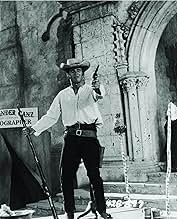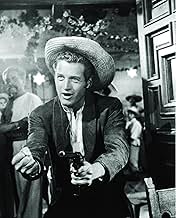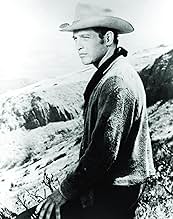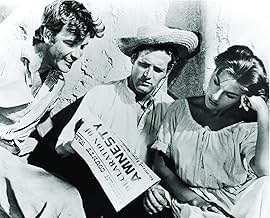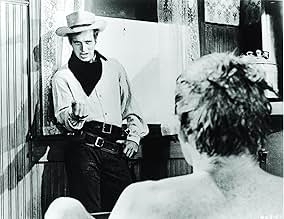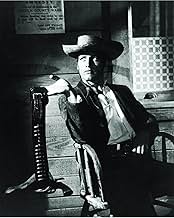VALUTAZIONE IMDb
6,4/10
4913
LA TUA VALUTAZIONE
Aggiungi una trama nella tua linguaAfter his employer is murdered by rival cattlemen, a troubled and uneducated young cowboy vows revenge on the murderers.After his employer is murdered by rival cattlemen, a troubled and uneducated young cowboy vows revenge on the murderers.After his employer is murdered by rival cattlemen, a troubled and uneducated young cowboy vows revenge on the murderers.
- Regia
- Sceneggiatura
- Star
- Premi
- 1 vittoria in totale
Robert Anderson
- Hill
- (as Bob Anderson)
Josephine Parra
- Bride
- (as Jo Summers)
Recensioni in evidenza
Billy The Kid has been played on screen by many actors, of whom Paul Newman may have been the most justly famous. So why is his Billy such a drip?
Newman was 33 years old and had managed to make the most of his second chance at screen fame with a solid turn in "Somebody Up There Likes Me," playing a rebellious young boxer. As Billy, though, Newman seems lost as a similar character of sudden impulse. "All I know is how I feel," he says, and that's true whether he's brooding Brando-like over the death of a rancher he just met or dancing up a storm three minutes later. For every scene he plays with his trademark cool, there must be four or five he exaggerates to strange effect.
It's a strange movie with or without him. Celebrated by some as a psychological western, it presents Billy as neither evil nor a sociopath, but rather as tied up by an understandable if extreme need for revenge. There was this guy, you see, who gave Billy a job and then got shot by some corrupt peace officers, and he promised to teach poor Billy to read.
Never mind that Billy doesn't know this guy when the movie starts and he's already dead ten minutes in. Nor that Billy's two partners-in-crime, Tom (James Best) and Charley (James Congdon), have no clear reason for siding with their hot-tempered friend. "The Left-Handed Gun" is a film in a hurry, mainly to give Newman as much opportunity to emote as possible. Boy, does Newman emote!
Compositionally, "The Left-Handed Gun" does some interesting things. We see Billy's first gunfight through a steamed-up window taking place while Billy simultaneously maps it out, a terrific effect. Director Arthur Penn and cinematographer J. Peverell Marley (not a harmonious team, as Penn reveals in a DVD commentary) continually find unique details to capture the eye, like one man's face pressed against a window glass after taking a fatal bullet. In his movie blog "Nothing Is Written," Groggy Dundee points out just how much of Penn's big escape scene made it into the later Sam Peckinpah movie "Pat Garrett And Billy The Kid," to the point of identical blocking and camera angles.
This is a better film that that one, which is overlong and cattywampus. Penn makes a point in his DVD commentary about the film being taken away from him in the editing room, and there's much sloppiness in evidence in the final cut, like Tom taking the same bullet in two consecutive scenes. But Penn must take the blame for a cast that overplays way too much, as if Newman's Method acting style was the swine flu. Best either whacks his hat or giggles constantly, while John Dehner as Pat Garrett has an atrocious scene where he whines at Billy for shooting a guy during his wedding reception.
"This wall, this street, this town, I married all of it," Dehner screams. I shudder to imagine the honeymoon.
Best's future "Dukes Of Hazzard" castmate Denver Pyle sticks out in a better way as the ornery Ollinger, while Hurd Hatfield coos over Billy as an overly florid Southern writer who wants to make his fortune writing up Billy's career. Considering this was based on a play by Gore Vidal, there may be a subtext there, though Hatfield works his few scenes more in the direction of a creepier Vincent Price. I liked him, even if I don't think he got across anything more than a hint of an idea about our exploitative celebrity culture.
That's the problem with "Left-Handed Gun," aiming too high and not getting what it shoots for. That and Newman, who shows some star power here but not much acting skill. Unlike Billy, he had time to get better.
Newman was 33 years old and had managed to make the most of his second chance at screen fame with a solid turn in "Somebody Up There Likes Me," playing a rebellious young boxer. As Billy, though, Newman seems lost as a similar character of sudden impulse. "All I know is how I feel," he says, and that's true whether he's brooding Brando-like over the death of a rancher he just met or dancing up a storm three minutes later. For every scene he plays with his trademark cool, there must be four or five he exaggerates to strange effect.
It's a strange movie with or without him. Celebrated by some as a psychological western, it presents Billy as neither evil nor a sociopath, but rather as tied up by an understandable if extreme need for revenge. There was this guy, you see, who gave Billy a job and then got shot by some corrupt peace officers, and he promised to teach poor Billy to read.
Never mind that Billy doesn't know this guy when the movie starts and he's already dead ten minutes in. Nor that Billy's two partners-in-crime, Tom (James Best) and Charley (James Congdon), have no clear reason for siding with their hot-tempered friend. "The Left-Handed Gun" is a film in a hurry, mainly to give Newman as much opportunity to emote as possible. Boy, does Newman emote!
Compositionally, "The Left-Handed Gun" does some interesting things. We see Billy's first gunfight through a steamed-up window taking place while Billy simultaneously maps it out, a terrific effect. Director Arthur Penn and cinematographer J. Peverell Marley (not a harmonious team, as Penn reveals in a DVD commentary) continually find unique details to capture the eye, like one man's face pressed against a window glass after taking a fatal bullet. In his movie blog "Nothing Is Written," Groggy Dundee points out just how much of Penn's big escape scene made it into the later Sam Peckinpah movie "Pat Garrett And Billy The Kid," to the point of identical blocking and camera angles.
This is a better film that that one, which is overlong and cattywampus. Penn makes a point in his DVD commentary about the film being taken away from him in the editing room, and there's much sloppiness in evidence in the final cut, like Tom taking the same bullet in two consecutive scenes. But Penn must take the blame for a cast that overplays way too much, as if Newman's Method acting style was the swine flu. Best either whacks his hat or giggles constantly, while John Dehner as Pat Garrett has an atrocious scene where he whines at Billy for shooting a guy during his wedding reception.
"This wall, this street, this town, I married all of it," Dehner screams. I shudder to imagine the honeymoon.
Best's future "Dukes Of Hazzard" castmate Denver Pyle sticks out in a better way as the ornery Ollinger, while Hurd Hatfield coos over Billy as an overly florid Southern writer who wants to make his fortune writing up Billy's career. Considering this was based on a play by Gore Vidal, there may be a subtext there, though Hatfield works his few scenes more in the direction of a creepier Vincent Price. I liked him, even if I don't think he got across anything more than a hint of an idea about our exploitative celebrity culture.
That's the problem with "Left-Handed Gun," aiming too high and not getting what it shoots for. That and Newman, who shows some star power here but not much acting skill. Unlike Billy, he had time to get better.
The director of Bonnie & Clyde and Little Big Man is off to a promising start with The Left Handed Gun, his first film. The film stars a young Paul Newman as Billy the Kid. Billy, working as a ranch hand, swears revenge on the four men who ambushed and killed his boss.
That's about it for plot. Newman plays Billy well, portraying a man bent on his mission. One senses that he means well, but his short temper and dark past always get the best of him, even during his friend's, Pat Garrett (John Dehner in a nice performance), wedding.
Unfortunately, Newman suffers from a weak supporting cast and little character development. I found it hard to believe that Billy could develop such a strong bond with his boss in such a short time (although the movie doesn't exactly specify how long). With the possible exception of Garrett, the remaining players are there to fill up the screen.
In short, I wasn't disappointed with this film, but if you want to view a great Western about a man driven by revenge, definitely see John Wayne in The Searchers.
That's about it for plot. Newman plays Billy well, portraying a man bent on his mission. One senses that he means well, but his short temper and dark past always get the best of him, even during his friend's, Pat Garrett (John Dehner in a nice performance), wedding.
Unfortunately, Newman suffers from a weak supporting cast and little character development. I found it hard to believe that Billy could develop such a strong bond with his boss in such a short time (although the movie doesn't exactly specify how long). With the possible exception of Garrett, the remaining players are there to fill up the screen.
In short, I wasn't disappointed with this film, but if you want to view a great Western about a man driven by revenge, definitely see John Wayne in The Searchers.
Based on Gore Vidal's play (which had already been filmed once for television with Newman), THE LEFT HANDED GUN is an unusual addition to the western genre, with several considerable attempts at psychoanalysis that were slightly ahead of the time for this type of picture. The film is more or less a bio of infamous outlaw Billy the Kid, with the novelty that Billy (played by Newman) is sympathetically portrayed more as a misunderstood youth rather than an outright criminal. Director Arthur Penn and screenwriter Leslie Stevens (working from Vidal's original play) have done a commendable job at presenting Vidal's revolutionist vision of Billy, even though the film sometimes rambles and lacks the streamlined momentum that made Penn's similar BONNIE AND CLYDE (1967) an American film masterpiece. The entire story was filmed much more effectively in Sam Peckinpah's cult classic PAT GARRETT & BILLY THE KID (1973), but THE LEFT HANDED GUN stands as an interesting curio and a film that (aside from some overwrought acting) has aged very well. This was yet another role that was originally intended to be played by James Dean that Newman stepped into after that young actor's tragic death. Unlike 1956's SOMEBODY UP THERE LIKES ME (which Newman played to perfection), I actually think that Dean might have actually been better suited to play Billy the Kid, as his nervy stance and cocksure demeanor have yet to be match by anyone and possibly could have enhanced the role even further. Newman is still quite good, however, playing the role as closely to Vidal's original concept as possible, and there is a particularly lovely scene with Newman's reaction as Billy to a Biblical verse remaining one of my favorite pieces of reactive acting ever. The sympathetic portrayal of Billy the Kid also gave Newman his first real shot at playing an anti-hero, a task that he would later perfect in the 24-Karat film masterpieces THE HUSTLER (1961) and HUD (1963).
I wonder what the mature Paul Newman thought of this early movie performance. Of course, 'mature' is a relative term since he's already 33 here, well beyond the 'kid' range. In my little book, it's the most mannered and misdirected acting of his long and distinguished career. It's almost like he's working at an excess of James Dean. That wouldn't be surprising since the screenplay's Billy comes across as more misunderstood youth than cold-blooded killer. I guess this is the first of director Penn's efforts at rehabilitating notorious American outlaws, leading up to the glossy Bonnie and Clyde (1967).
The movie itself is pretty good, the open range locations even looking like eastern New Mexico, while Penn uses them to good effect. But it's really James Best as the ill-fated henchman Tom who steals the film. His supporting role manages a certain poignancy that should have come from Billy, but doesn't. With the right breaks, I think Best could have carved a real niche in films. Speaking of supporting players, with the exception of the cartoonish Moultrie (Hatfield), they appear recruited from the many TV Westerns of the day, especially the familiar Denver Pyle and the classy John Dehner.
Penn establishes himself here as a moviemaker to watch with a number of nice touches— having Pyle squint into the sun just before the fateful moment, the lone boot left standing in the road, and others. I'm kind of sorry that the baby-faced Audie Murphy didn't get a shot at Billy's role. Visually, he's perfect. Plus, surprisingly for that boyish appearance, he could do a killer-stare to make you believe he killed 100 Germans during the war. Also, Murphy could have made that key facedown scene with Joe Bell (Pryor) as genuinely chilling as it should be. For whatever the charming Newman's considerable skills, being downright mean is not one of them. Anyway the movie remains an interesting entry on the road to 1960's-style rebellious movie-making.
The movie itself is pretty good, the open range locations even looking like eastern New Mexico, while Penn uses them to good effect. But it's really James Best as the ill-fated henchman Tom who steals the film. His supporting role manages a certain poignancy that should have come from Billy, but doesn't. With the right breaks, I think Best could have carved a real niche in films. Speaking of supporting players, with the exception of the cartoonish Moultrie (Hatfield), they appear recruited from the many TV Westerns of the day, especially the familiar Denver Pyle and the classy John Dehner.
Penn establishes himself here as a moviemaker to watch with a number of nice touches— having Pyle squint into the sun just before the fateful moment, the lone boot left standing in the road, and others. I'm kind of sorry that the baby-faced Audie Murphy didn't get a shot at Billy's role. Visually, he's perfect. Plus, surprisingly for that boyish appearance, he could do a killer-stare to make you believe he killed 100 Germans during the war. Also, Murphy could have made that key facedown scene with Joe Bell (Pryor) as genuinely chilling as it should be. For whatever the charming Newman's considerable skills, being downright mean is not one of them. Anyway the movie remains an interesting entry on the road to 1960's-style rebellious movie-making.
One of the strangest westerns ever made. Arthur Penn's "The Left Handed Gun", adapted from a play by Gore Vidal, came right at the height of the 'teenage rebel' cycle of the fifties with Paul Newman's Billy the Kid having more in common with James Dean's Jim Stark than any Western outlaw I can think of. The film wasn't a success; it's highfalutin dialogue and over-the-top acting proving too much for a general audience who, if they looked just below the surface, would have easily detected a homosexual subplot involving Hurd Hatfield's character who acts as a kind of Greek Chorus. It marked the screen debut of Penn who didn't make another film for four years though it's now built up something of a cult reputation. It isn't really very good, and it is very self-concious, but it is also too bizarre to dismiss out of hand.
Lo sapevi?
- QuizPaul Newman was widely felt to be miscast as Billy the Kid since at 33 he was considerably older than the character. Billy was supposed to be 18 at the beginning of the film.
- BlooperThe film is about western outlaw Billy the Kid, who was actually right-handed.
- ConnessioniFeatured in Legends of the West (1992)
I più visti
Accedi per valutare e creare un elenco di titoli salvati per ottenere consigli personalizzati
- How long is The Left Handed Gun?Powered by Alexa
Dettagli
- Data di uscita
- Paese di origine
- Lingue
- Celebre anche come
- Billy Kid - il leggendario mancino del West
- Luoghi delle riprese
- Aziende produttrici
- Vedi altri crediti dell’azienda su IMDbPro
Botteghino
- Budget
- 700.000 USD (previsto)
- Lordo in tutto il mondo
- 5066 USD
- Tempo di esecuzione1 ora 42 minuti
- Colore
- Proporzioni
- 1.85 : 1
Contribuisci a questa pagina
Suggerisci una modifica o aggiungi i contenuti mancanti

Divario superiore
What is the French language plot outline for Furia selvaggia (Billy Kid) (1958)?
Rispondi

